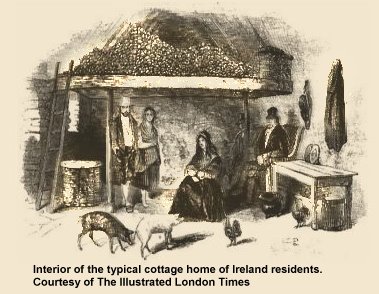The Losty Family History
1700's to Present - Illustrated Narrative
KILDARE IRELAND
Our story begins in the rolling farmlands of Kildare County Ireland.Throughout Kildare today, ruined monasteries, Round Towers, ancient villages and the magnificent CastleTown House of Celbridge remind the visitor of the area's rich heritage.

During the Late 1700's the family of Mr. Losty was living in Kildare County Ireland. County Kildare is located in Leinster, part of the Great Central Plain, a region of rolling farmland on a limestone base, dominated by the 22 square miles of the Curagh Plain. Southwest Kildare is bound by the Wicklow mountains and two major rivers cut through Kildare soil. The river Liffey flows into Dublin, and the Barrow flows through Athy in the southern tip of the county.
On or about the turn of the Century Mr. Losty, now married, welcomed the birth of his son Matthew J. Losty. It is unknown, at this time, the names of Matthew J. Losty's siblings; however, there is a possibility John Losty of Kildare Ireland, whose children immigrated to the state of Connecticut and who frequently visited the Berkshire Hills of Massachusetts, is a brother to Matthew. As we continue to gather clues and evidence, we will incorporate our findings into our story. Matthew's bride to be, Mary Jane (Unknown), was born in 1780 and it is the lives of her two boys, John and Patrick which is told in the following narrative.
Ireland 1739 - 1843
The famine that took the lives of so many Irish people began in 1739 and peaked in 1843. It is important to note there were many other issues the Irish were dealing with that influenced their decisions to leave but lack of food was at the top of the list.The use of the potato, in 1725, was so general in Ireland (at least in parts of the country) it served as the staple food poor families relied on for nearly the entire winter. The first great destruction of the potato crop occurred in the winter of 1739. It was said the potato crop was destroyed in one night and 300,000 people perished of famine. The people of Ireland were cautioned the following year against eating potatoes, which were believed to be diseased and likely to produce disease in them if they ingested it. This rhetoric caused fights to break out among Potato Farmers and the Market Gardeners. The Market Gardeners were glorifying the destruction of the "foreign root" which had been brought into Ireland in 1600 by Sir Walter Raleigh.

Between the years, 1765 and 1880, Mr. and Mrs. Losty, welcomed the birth of their son Matthew J. Losty. During this time, the quantity of rain and excessive droughts during the summer months contributed to the curl and black rot diseases that were impacting the potato crops producing small potatoes in scarce numbers and in several years complete failures of the crops of potatoes and cabbages, specifically during the years 1765, 1770, 1795 and 1800.
Note: We do not have a date of birth or death on Matthew J. Losty, however, Matthew's wife, Mary Jane, was born in 1780 and we estimate Matthew's date of birth to be near that time.
In 1800, disease appeared in the potato stalks and the harvests were generally bad. Great scarcity and distress succeeded. The potato also failed in England that year and for some years afterward the curl injured many of the best varieties. In 1807 nearly one-half of the potato crops were destroyed by frost adding to the death toll among the poor. Matthew and Mary were about twenty seven years old during this year and most likely already married and welcoming the births of their children.
Continue reading our story